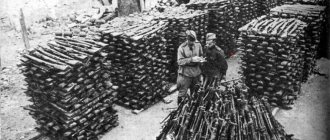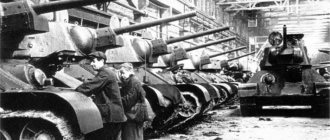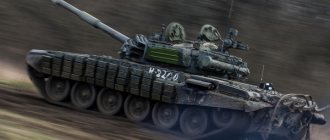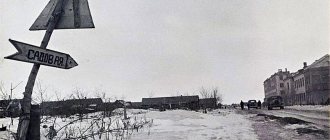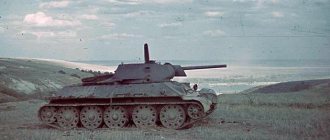Start of the war
The implementation of the Barbarossa plan began at dawn on June 22, 1941 with extensive air bombing of the largest industrial and strategic centers, as well as the offensive of the ground forces of Germany and its allies along the entire European border of the USSR (over 4.5 thousand km).
In the first few days, German troops advanced tens and hundreds of kilometers. In the central direction, at the beginning of July 1941, all of Belarus was captured, and German troops reached the approaches to Smolensk. In the north-west, the Baltic states were occupied, Leningrad was blocked on September 9. In the south, Hitler's troops occupied Moldova and Right Bank Ukraine. Thus, by the autumn of 1941, Hitler’s plan to seize the vast territory of the European part of the USSR was carried out. The rapid advance of German troops on the Soviet front and their successes in the summer campaign were explained by many objective and subjective factors. Germany had significant economic and military-strategic advantages. To strike the Soviet Union, it used not only its own, but also the resources of allied, dependent and occupied countries of Europe. Hitler's command and troops had experience in modern warfare and broad offensive operations, accumulated during the first stage of World War II. The technical equipment of the Wehrmacht (tanks, aircraft, communications equipment, etc.) was significantly superior to the Soviet one in mobility and maneuverability.
The Soviet Union, despite the efforts made during the Third Five-Year Plan, did not complete its preparations for war. The rearmament of the Red Army was not completed. Military doctrine assumed the conduct of operations on enemy territory. In this regard, defensive lines on the old Soviet-Polish border were dismantled, and new ones were not created quickly enough. J.V. Stalin’s biggest miscalculation was his lack of faith in the start of the war in the summer of 1941. Therefore, the entire country and, first of all, the army and its leadership were not prepared to repel aggression. As a result, in the first days of the war, a significant part of Soviet aviation was destroyed right at the airfields. Large formations of the Red Army were surrounded, destroyed or captured.
Immediately after the German attack, the Soviet government carried out major military-political and economic measures to repel aggression. On June 23, the Headquarters of the Main Command was formed. On July 10, it was transformed into the Headquarters of the Supreme High Command. It included I.V. Stalin (appointed Commander-in-Chief and soon became People's Commissar of Defense), V.M. Molotov, S.K. Timoshenko, S.M. Budyonny, K.E. Voroshilov, B.M. Shaposhnikov and G. K. Zhukov. By a directive of June 29, the Council of People's Commissars of the USSR and the Central Committee of the All-Union Communist Party of Bolsheviks set the entire country the task of mobilizing all forces and means to fight the enemy. On June 30, the State Defense Committee (GKO) was created, concentrating all power in the country. The military doctrine was radically revised, the task was put forward to organize strategic defense, wear down and stop the advance of the fascist troops. Large-scale events were carried out to transfer industry to a military footing, mobilize the population into the army and build defensive lines.
At the end of June - the first half of July 1941, large defensive border battles unfolded (defense of the Brest Fortress, etc.). From July 16 to August 15, the defense of Smolensk continued in the central direction. In the northwestern direction, the German plan to capture Leningrad failed. In the south, the defense of Kyiv was carried out until September 1941, and Odessa until October. The stubborn resistance of the Red Army in the summer and autumn of 1941 thwarted Hitler's plan for a lightning war. At the same time, the capture by the Nazis by the fall of 1941 of the vast territory of the USSR with its most important industrial centers and grain regions was a serious loss for the Soviet government.
The situation on the eve of the war
The Nazis, led by Hitler, after coming to power in Germany, headed for the abolition of the articles of the Treaty of Versailles. With the connivance of the governments of Great Britain and France, Germany occupied Austria by 1939 and partitioned Czechoslovakia, significantly increasing its military and industrial potential.
Seeing the aggressiveness of the Third Reich, in the spring of 1939
The Soviet Union proposed to the Western powers to sign a trilateral treaty of mutual assistance between the USSR, France and Great Britain, but was actually refused.
Then the USSR moved towards rapprochement with Germany, and on August 23, 1939
In 2010, a non-aggression pact was signed between the Soviet Union and Germany for a period of 10 years, known as
the Molotov-Ribbentrop Pact
.
The treaty also included a secret protocol that stipulated the division of spheres of influence between countries in Eastern Europe. This treaty gave Hitler a free hand for a new war in Europe.
September 1, 1939
Germany attacked Poland, and on September 3, fulfilling allied obligations, France and Great Britain declared war on Germany. The Second World War began. By September 17, German troops defeated the main forces of the Polish army. On the same day, Soviet troops, according to a clause in the secret protocol, crossed the Soviet-Polish border and occupied the territories of Western Belarus and Ukraine under the pretext of protecting fraternal peoples. Poland's Western allies made no significant offensive attempts on the Western Front.
Polish Wehrmacht campaign / Photo: ursa-tm.ru
November 30, 1939
The Soviet Union declared war on Finland after its refusal to exchange part of the Karelian Isthmus for a much larger part of Karelia. Only by March 1940, after significant losses, parts of the Red Army were able to break through the well-fortified Mannerheim Line, and Finland sued for peace. The unsuccessful actions of the Red Army in this war strengthened the opinion of the German command in the weakness of the Soviet Union.
Soviet-Finnish War: Photo: mtdata.ru
In April 1940
Germany occupied Denmark and Norway, and on May 10 invaded France through the Low Countries and within a month and a half defeated the French army and brought it out of the war.
No one expected such a turn of events. It was assumed that the war on the Western Front would take on a positional character, as during the First World War.
French campaign of the Wehrmacht / Photo: map-site.narod.ru
Summer 1940
With the active participation of the Soviet Union, elections were held in Lithuania, Latvia and Estonia. The victorious pro-Soviet forces proclaimed the creation of socialist republics, and in August the latter were accepted into the USSR.
Also in June 1940
, relying on a clause in the secret protocol, the USSR put forward an ultimatum to Romania to transfer Bessarabia and Northern Bukovina to it. After the introduction of units of the Red Army into these lands, the Moldavian SSR was formed.
Spring 1941
years, with the assistance of the troops of its allies, Germany occupied Yugoslavia and Greece. After the end of the Balkan campaign, Germany began secretly transferring its troops to the western borders of the Soviet Union.
By June 1941
Almost all of continental Europe came under the control of Hitler's Germany. Having refused the proposed truce, only Great Britain continued the war against the Third Reich.
Map of Europe by June 22, 1941 / Photo: aagokeh.xn
Moscow Battle
At the end of September - beginning of October 1941, the German Operation Typhoon began, aimed at capturing Moscow. The first line of Soviet defense was broken through in the central direction on October 5-6. Bryansk and Vyazma fell. The second line near Mozhaisk delayed the German offensive for several days. On October 10, G.K. Zhukov was appointed commander of the Western Front. On October 19, a state of siege was introduced in the capital. In bloody battles, the Red Army managed to stop the enemy - the October stage of Hitler’s offensive on Moscow ended.
The three-week respite was used by the Soviet command to strengthen the defense of the capital, mobilize the population into the militia, accumulate military equipment and, above all, aviation. On November 6, a ceremonial meeting of the Moscow Council of Workers' Deputies was held, dedicated to the anniversary of the October Revolution. On November 7, a traditional parade of units of the Moscow garrison took place on Red Square. For the first time, other military units also took part in it, including militias who left straight from the parade to the front. These events contributed to the patriotic upsurge of the people and strengthened their faith in victory.
The second stage of the Nazis’ offensive on Moscow began on November 15, 1941. At the cost of huge losses, they managed to reach the approaches to Moscow in late November - early December, enveloping it in a semicircle in the north in the Dmitrov area (Moscow-Volga canal), in the south - near Tula. At this point the German offensive fizzled out. The defensive battles of the Red Army, in which I killed soldiers and militias, were accompanied by the accumulation of forces at the expense of Siberian divisions, aviation and other military equipment. On December 5-6, the Red Army's counteroffensive began, as a result of which the enemy was thrown back 100-250 km from Moscow. Kalinin, Maloyaroslavets, Kaluga, and other cities and towns were liberated. Hitler's plan for a lightning war completely failed.
In the winter of 1942, units of the Red Army carried out offensives on other fronts. However, breaking the blockade of Leningrad failed. In the south, the Kerch Peninsula and Feodosia were liberated from the Nazis. The victory near Moscow in conditions of the enemy’s military-technical superiority was the result of the heroic efforts of the Soviet people.
Latest abstracts of the section
- Analysis of the Napoleonic Wars era
- Arabia in the early Middle Ages. Formation of a pan-Arab early feudal state
- Bashkortostan in the post-war period
- The Bulgarian vector in the foreign policy of the USSR and the activities of the Comintern in the Balkans
- Boris Godunov, crime and punishment
- The struggle of the Belarusian people against polonization
- The struggle for independence in the countries of Tropical Africa
Copyright © 2010-2022 — www.refsru.com — abstracts, coursework and dissertations
Summer-autumn campaign of 1942
In the summer of 1942, the fascist leadership relied on capturing the oil regions of the Caucasus, the fertile regions of southern Russia and the industrial Donbass. JV Stalin made a new strategic mistake in assessing the military situation, in determining the direction of the enemy’s main attack, in underestimating his forces and reserves. In this regard, his order for the Red Army to advance simultaneously on several fronts led to serious defeats near Kharkov and in the Crimea. Kerch and Sevastopol were lost.
At the end of June 1942, a general German offensive unfolded. Fascist troops, during stubborn battles, reached Voronezh, the upper reaches of the Don and captured Donbass. Then they broke through our defenses between the Northern Donets and the Don. This made it possible for Hitler's command to solve the main strategic task of the summer campaign of 1942 and launch a broad offensive in two directions: to the Caucasus and to the east - to the Volga.
In the Caucasian direction, at the end of July 1942, a strong Nazi group crossed the Don. As a result, Rostov, Stavropol and Novorossiysk were captured. Stubborn fighting took place in the central part of the Main Caucasus Range, where specially trained enemy alpine riflemen operated in the mountains. Despite the successes achieved in the Caucasian direction, the fascist command was never able to solve its main task - to break into the Transcaucasus to seize the oil reserves of Baku. By the end of September, the offensive of fascist troops in the Caucasus was stopped.
An equally difficult situation for the Soviet command arose in the eastern direction. To cover it, the Stalingrad Front was created under the command of Marshal S.K. Timoshenko. In connection with the current critical situation, Order No. 227 of the Supreme Commander-in-Chief was issued, which stated: “To retreat further means to ruin ourselves and at the same time our Motherland.” At the end of July 1942, the enemy under the command of General von Paulus struck a powerful blow on the Stalingrad front. However, despite the significant superiority in forces, within a month the fascist troops managed to advance only 60-80 km and with great difficulty reached the distant defensive lines of Slalin-fada. In August they reached the Volga and intensified their offensive.
From the first days of September, the heroic defense of Stalingrad began, which lasted virtually until the end of 1942. Its significance during the Great Patriotic War was enormous. During the struggle for the city, Soviet troops under the command of generals V.I. Chuikov and M.S. Shumilov in September - November 1942 repelled up to 700 enemy attacks and passed all tests with honor. Thousands of Soviet patriots showed themselves heroically in the battles for the city. As a result, enemy troops suffered colossal losses in the battles for Stalingrad. Every month of the battle, about 250 thousand new Wehrmacht soldiers and officers, the bulk of military equipment, were sent here. By mid-November 1942, the Nazi troops, having lost more than 180 thousand people killed and 500 thousand wounded, were forced to stop the offensive.
During the summer-autumn campaign, the Nazis managed to occupy a huge part of the European part of the USSR, where about 15% of the population lived, 30% of gross output was produced, and more than 45% of the cultivated area was located. However, it was a Pyrrhic victory. The Red Army exhausted and bled the fascist hordes. The Germans lost up to 1 million soldiers and officers, more than 20 thousand guns, over 1,500 tanks. The enemy was stopped. The resistance of the Soviet troops made it possible to create favorable conditions for their transition to a counteroffensive in the Stalingrad area.
Soviet-German front during the Great Patriotic War
The Great Patriotic War began on June 22, 1941 with the attack of the troops of Germany and its allies (Finland, Hungary, Romania, Italy, etc.) on the USSR and lasted until May 9, 1945. Its duration was 1418 days.
On the eve of the invasion of the USSR, the Nazi leadership developed several plans. The plan for the reorganization of the USSR after the conquest by Germany was called “Ost”. It provided for the destruction of the USSR and the dismemberment of its territory. It was planned to form German provinces on the occupied lands. The goal was to destroy the majority of the Soviet population, especially the Slavic ones, and turn the remainder into slaves serving the German colonists. Humane treatment of civilians, as well as prisoners of war, was rejected. The occupied territory of the USSR was supposed to meet Germany's needs for raw materials, labor, and food.
The plan of military action against the USSR was called “Barbarossa”. It provided for simultaneous strikes in three main directions: Leningrad (Army Group North), Moscow (“). In 6-7 weeks, the Wehrmacht troops were supposed to reach the Arkhangelsk - Astrakhan line, i.e. capture the entire European part of the country. It was a plan for lightning war (blitzkrieg).
The Great Patriotic War is usually divided into three stages:
1) June 22, 1941 – November 18, 1942 – the initial period of the war. At this stage, the strategic initiative, i.e. the ability to plan and conduct large-scale offensive operations belonged to Germany and its allies.
On June 22, 1941, Germany and its allies attacked the USSR without declaring war. Already in the first three weeks of fighting, German troops advanced 300-600 km deep into Soviet territory, occupying Latvia, Lithuania, Belarus, right-bank Ukraine, and Moldova.
The catastrophic start of the war for the USSR was explained by the significant superiority of Germany, which used the resources of all of Europe with the exception of Great Britain. The German command and German troops had successful experience in conducting military campaigns in Europe, superiority in manpower and technical equipment of the troops. The surprise of the attack played a role - until the last Stalin was afraid of provoking the Nazi leadership and giving a reason to accuse the USSR of preparing for war with Germany. Due to erroneous orders to attack in the first days of the war, hundreds of thousands of Red Army soldiers were doomed to death or captivity.
On June 30, the State Defense Committee (GKO) was formed, which concentrated all the fullness of state and party power. It was headed by I.V. Stalin, who later became the Supreme Commander-in-Chief.
The defense of Smolensk, Kyiv, Leningrad began in July, and Odessa in August. On September 8, Leningrad was blocked, the defense of Smolensk lasted until September 10, and on September 19, Kyiv was captured. The fierce resistance of the troops, the unparalleled heroism of the soldiers, the defensive battles for Smolensk, Kyiv, Leningrad, Odessa thwarted the Wehrmacht's plan for a lightning war. The unfolding partisan movement helped disrupt the blitzkrieg. Examples of heroism in the first days of the war were the defenders of the Brest Fortress, who defended themselves for almost a month, pilot N.F. Gastello, who directed his crippled plane at a concentration of German equipment, etc. On August 7, the first night ramming in the history of the war was carried out by V.V. Talalikhin.
On September 30, 1941, German troops began implementing the Typhoon plan, the goal of which was to capture the capital. The Battle of Moscow lasted from September 30, 1941 to January 7, 1942. The German offensive broke through several defense lines and created the threat of capturing Moscow. On October 10, G.K. was appointed commander of the Western Front. Zhukov. All possible measures were taken to hold the capital. Muscovites built defensive structures, and thousands of militias were sent to the front. In the battles near Moscow, Panfilov’s men, soldiers of the 316th Infantry Division under the command of Major General I.V., became famous for their selfless defense. Panfilova.
At the cost of enormous efforts, the German offensive was stopped. At the same time, a counteroffensive was being prepared. After receiving intelligence data that Japan was not planning to attack the USSR, fresh divisions began to be transferred from the Far East.
December 5-6, 1941 The Red Army launched a counteroffensive. On November 7, the traditional parade of the Moscow garrison took place on Red Square. For the first time, other military units also took part in it, including militias who left straight from the parade to the front.
As a result of the counteroffensive, the Moscow, Tula and significant parts of the Kalinin region were liberated. The front line was pushed back by 100-250 km. Germany suffered its first major defeat in World War II. Its allies, Türkiye and Japan, refrained from speaking out against the USSR. The strategic initiative temporarily passed to the USSR.
However, the situation in the USSR by the beginning of 1942 was very difficult. The irretrievable losses of Soviet troops in 1941 amounted to 3.1 million people (of which 0.8 million were killed or died from wounds, 2.3 million were missing or captured). Together with sanitary losses (wounded, shell-shocked, sick), losses increased to 4.5 million people. The Nazis occupied areas in which, in peacetime, 40% of the country's population lived, 70% of cast iron, 60% of steel and aluminum, 40% of railway equipment, 65% of coal, 85% of sugar and 40% of grain were produced.
Inspired by the success in the Battle of Moscow, Stalin ordered an offensive on all fronts in 1942 to finally defeat the invaders. Not provided with sufficient resources, these offensives ended in particularly severe defeats in the Crimea and near Kharkov in May 1942, near Leningrad in May-June 1942. During the exit from the encirclement near Leningrad, the commander of the 2nd Shock Army, General A.A. Vlasov was captured and agreed to cooperate with the fascists, becoming the head of a military organization of collaborators (traitors) from Soviet prisoners of war - the Russian Liberation Army (ROA).
In the summer of 1942, the German command decided to launch the main attack in the southern direction. It relied on capturing the oil regions of the Caucasus, the fertile regions of southern Russia and the industrial Donbass. Having occupied Kharkov and Crimea, German troops again seized the strategic initiative. They occupied Donbass and reached the North Caucasus. Despite the successes achieved in the Caucasian direction, the fascist command never managed to break into the Transcaucasus to seize the oil reserves of Baku. By the end of September, the offensive of fascist troops in the Caucasus was stopped.
The main battle of 1942 took place near Stalingrad. The Nazis sought to cut the Volga as a transport artery through which the main supplies of oil went. If they had succeeded, the Red Army would have had major shortages of fuel. On July 17, 1942, the defensive phase of the Battle of Stalingrad began, which lasted until November 18. Our troops suffered heavy losses and could not withstand the powerful onslaught of the Wehrmacht. In connection with the current critical situation, order No. 227 (“Not a step back!”) was issued, which categorically prohibited retreat.
At the end of August, German units reached the Volga, fighting began in Stalingrad, which was defended by armies under the command of generals V.I. Chuikov and M.S. Shumilova. One of the heroes of the defense was Sergeant Ya.F. Pavlov, who with his soldiers held a house on the banks of the Volga for two months. Soviet snipers successfully operated in the ruins of Stalingrad, one of whom, V.G. Zaitsev, destroyed 225 German soldiers in the city. Stalingrad was almost completely destroyed, but the Nazis failed to take it.
2) November 19, 1942 – end of 1943 – a period of radical change, i.e. the final transfer of strategic initiative to the USSR.
The stage began with a counteroffensive of Soviet troops near Stalingrad on November 19, 1942. Already on November 23, more than 330 thousand German soldiers and officers were surrounded. The offensive phase of the Battle of Stalingrad ended with the destruction and capture of the encircled troops on February 2, 1943.
After the successful implementation of the Stalingrad operation, G.K. Zhukov and A.M. Vasilevsky was the first in the country to be awarded the title of Marshal of the Soviet Union. In 1944, 6 more outstanding commanders became marshals: I.S. Konev, L.A. Govorov, K.K. Rokossovsky, R.Ya. Malinovsky, F.I. Tolbukhin, K.A. Meretskov.
The victory in the Battle of Stalingrad led to a widespread offensive by the Red Army on all fronts: in January 1943, the blockade of Leningrad was partially broken; in February, the North Caucasus was liberated.
The radical turning point in the course of the war, which began at Stalingrad, was completed as a result of the victory in the Battle of Kursk (July - August 1943). During the Battle of Kursk near Prokhorovka on July 12, the largest tank battle of World War II took place. About 1,200 tanks and self-propelled guns took part in the battle on both sides. Both sides suffered heavy losses, but Soviet troops were able to survive.
As a result of the defeat of the Nazi troops near Kursk in August 1943, Soviet troops captured Orel and Belgorod. In September, Left Bank Ukraine and Donbass were liberated, in October the Dnieper was crossed, and Kyiv was captured in November.
The radical change was ensured primarily by the superiority of the military economy: in 1943, the Red Army was armed in sufficient quantities with the latest types of weapons, many of which were significantly superior to their German counterparts.
3) 1944 - May 9, 1945 - the final period, characterized by the liberation of the entire territory of the USSR and the liberation missions of the Red Army in Europe (liberation of Poland, Czechoslovakia, Hungary and other countries).
On January 27, 1944, the siege of Leningrad, which had lasted almost 900 days, was finally lifted. There were no more than 550 thousand inhabitants left in the city, but the number of victims exceeded a million, two-thirds of which were those who died from exhaustion.
In March, Soviet troops reached the USSR state border with Romania. At the end of August, the Iasi-Kishinev operation began, as a result of which Moldova was liberated. As a result of the major Operation Bagration (June-August 1944), Belarus and part of the Baltic states were liberated.
On June 6, 1944, the Western allies of the USSR, fearing that the defeat of Germany would be completed without them, landed their troops in northwestern France, in Normandy (Operation Overlord). The liberation of France began. By mid-September 1944, Anglo-American troops reached the western border of Germany. This forced the Soviet Union to intensify hostilities.
In November 1944, the troops of Germany and its allies were completely expelled from the territory of the USSR. At the end of 1944 and in the first months of 1945, Yugoslavia, Hungary, Poland, part of Austria, and Czechoslovakia were liberated. On April 13, 1945, the center of East Prussia, Koenigsberg, was taken.
The final battle of the Great Patriotic War was the Battle of Berlin. It began on April 16, and on May 2, the German capital capitulated. On the night of May 9, in the Berlin suburb of Karlhorst, the Act of Unconditional Surrender of the German Armed Forces was signed. On the Soviet side, the document was signed by G.K. Zhukov at 22:43 May 8 Central European Time or 00:43 May 9 Moscow time. The Great Patriotic War ended with the victory of the Soviet Union. May 9 was declared Victory Day in the USSR.
Battle of Stalingrad
Even during the fierce autumn battles, the Headquarters of the Supreme High Command began to develop a plan for a grandiose offensive operation designed to encircle and defeat the main forces of the Nazi troops operating directly near Stalingrad. G. K. Zhukov and A. M. Vasilevsky made a great contribution to the preparation of this operation, codenamed “Uranus”. To accomplish this task, three new fronts were created: Southwestern (N.F. Vatutin), Don (K.K. Rokossovsky) and Stalingrad (A.I. Eremenko). In total, the offensive group included more than 1 million people, 13 thousand guns and mortars, about 1000 tanks, 1500 aircraft.
On November 19, 1942, the offensive of the Southwestern and Don Fronts began. A day later, the Stalingrad Front advanced. The offensive was unexpected for the Germans. It developed at lightning speed and successfully. On November 23, 1942, a historic meeting and unification of the Southwestern and Stalingrad fronts took place. As a result, the German group at Stalingrad (330 thousand soldiers and officers under the command of General von Paulus) was surrounded.
Hitler's command could not come to terms with the current situation. He formed the Don Army Group consisting of 30 divisions. It was supposed to strike at Stalingrad, break through the outer front of the encirclement and connect with the 6th Army of von Paulus. However, an attempt made in mid-December to carry out this task ended in a new major defeat for German and Italian forces. By the end of December, having defeated this group, Soviet troops entered the Kotelnikovo area and began an attack on Rostov. This made it possible to begin the final destruction of the fascist troops surrounded at Stalingrad. On February 2, 1943, the remnants of von Paulus's army capitulated.
The victory in the Battle of Stalingrad led to a widespread offensive by the Red Army on all fronts: in January 1943, the blockade of Leningrad was broken; in February - the North Caucasus was liberated; in February - March - in the central (Moscow) direction the front line moved back by 130-160 km. As a result of the autumn-winter campaign of 1942/43, the military power of Nazi Germany was significantly undermined.
Battle of Kursk
In the central direction, after successful actions in the spring of 1943, the so-called Kursk ledge was formed on the front line. Hitler's command, wanting to regain the strategic initiative, developed Operation Citadel to break through and encircle the Red Army in the Kursk region. Unlike 1942, the Soviet command guessed the enemy’s intentions and created a deeply layered defense in advance.
The Battle of Kursk is the largest battle of World War II. About 900 thousand people, 1.5 thousand tanks (including the latest models - “tiger”, “panther”), more than 2 thousand aircraft were involved in it from Germany; on the Soviet side - more than 1 million people, 3,400 tanks and about 3 thousand aircraft. The Battle of Kursk was commanded by outstanding commanders: Marshals G.K. Zhukov and A.M. Vasilevsky, Generals N.F. Vatutin and K.K. Rokossovsky. Strategic reserves were created under the command of General I.S. Konev, since the Soviet plan command provided for a transition from defense to further offensive.
On July 5, 1943, a massive offensive of German troops began. After tank battles unprecedented in world history (the battle of the village of Prokhorovka, etc.) on July 12, the enemy was stopped. The counter-offensive of the Red Army began.
As a result of the defeat of the Nazi troops near Kursk in August 1943, Soviet troops captured Orel and Belgorod. In honor of this victory, a salute of 12 artillery salvoes was fired in Moscow on August 5. Continuing the offensive, Soviet troops dealt a crushing blow to the Nazis during the Belgorod-Kharkov operation. In September, Left Bank Ukraine and Donbass were liberated, in October the Dnieper was crossed, and Kyiv was captured in November.
